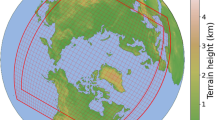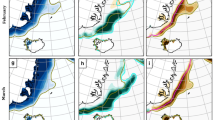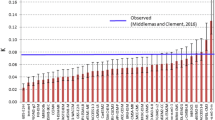Abstract
Low-level temperature inversions are a common feature of the wintertime troposphere in the Arctic and Antarctic. Inversion strength plays an important role in regulating atmospheric processes including air pollution, ozone destruction, cloud formation, and negative longwave feedback mechanisms that shape polar climate response to anthropogenic forcing. The Atmospheric Infrared Sounder (AIRS) instrument provides reliable measures of spatial patterns in mean wintertime inversion strength when compared with available radiosonde observations and reanalysis products. Here, we examine the influence of sea ice concentration on inversion strength in the Arctic and Antarctic. Correlation of inversion strength with mean annual sea ice concentration, likely a surrogate for the effective thermal conductivity of the wintertime ice pack, yields strong, linear relationships in the Arctic (r = 0.88) and Antarctic (r = 0.86). We find a substantially greater (stronger) linear relationship between sea ice concentration and surface air temperature than with temperature at 850 hPa, lending credence to the idea that sea ice controls inversion strength through modulation of surface heat fluxes. As such, declines in sea ice in either hemisphere may imply weaker mean inversions in the future. Comparison of mean inversion strength in AIRS and global climate models (GCMs) suggests that many GCMs poorly characterize mean inversion strength at high latitudes.








Similar content being viewed by others
References
Andreas EL, Murphy B (1986) Bulk transfer coefficients for heat and momentum over leads and polynyas. J Phys Oceanogr 16:1875–1883
Armstrong AE, Tremblay LB, Mysak LA (2003) A data-model intercomparison study of Arctic sea ice variability. Clim Dyn 20:465–476. doi:10.1007/s00382-002-0284-2
Aumann HH et al (2003) AIRS/AMSU/HSB on the Aqua mission: design, science objectives, data products and processing system. IEEE Trans Geosci Remote Sens 41:253–264
Barrie LA, Bottenheim JW, Schnell RC, Crutzen RC, Rasmussen RA (1988) Ozone destruction and photochemical reactions at polar sunrise in the lower Arctic atmosphere. Nature 334:1875–1883
Boé J, Hall AD, Qu X (2009) Current GCMs’ unrealistic negative feedback in the Arctic. J Clim 22:4682–4695. doi:10.1175/2009JCLI2885.1
Bridgman HA, Schnell RC, Kahl JD, Herbert GA, Joranger E (1989) A major haze event near Point Barrow, Alaska: analysis of probable source regions and transport pathways. Atmos Environ 23:2537–2549
Bromwich DH, Wang SH (2005) Evaluation of the NCEP–NCAR and ECMWF 15- and 40-Yr reanalyses using rawinsonde data from two independent arctic field experiments. Mon Wea Rev 133:3562–3578
Chahine MT et al (2006) The Atmospheric Infrared Sounder (AIRS): improving weather forecasting and providing new insights into climate. Bull Am Meteorol Soc 87:891–894. doi:10.1175/BAMS-87-7-891
Comiso J (1990, updated 2005) DMSP SSM/I daily and monthly polar gridded sea ice concentrations, 2002–2008. In Maslanik J, Stroeve J (eds) National Snow and Ice Data Center, Boulder, Colorado USA http://nsidc.org/data/nsidc-0002.html. Accessed 07 Jul 2009
Connolley WM (1996) The Antarctic temperature inversion. Int J Climatol 16:1333–1342
Curry JA, Rossow WB, Randall D, Schramm JL (1996) Overview of Arctic cloud and radiation characteristics. J Clim 9:1731–1764
Divakarla MG, Barnet CD, Goldberg MD, McMillin LM, Maddy E, Wolf W, Zhou L, Liu X (2006) Validation of Atmospheric Infrared Sounder temperature and water vapor retrievals with matched radiosonde measurements and forecasts. J Geophys Res 111:D09S15. doi:10.1029/2005JD006116
Fetzer EJ, Teixeira J, Olsen E, Fishbein E (2004) Satellite remote sounding of atmospheric boundary layer temperature inversions over the subtropical eastern Pacific. Geophys Res Lett 31:L17102. doi:10.1029/2004GL020174
Francis JA, Chan W, Leathers DJ, Miller JR, Veron DR (2009) Winter northern hemisphere weather patterns remember summer Arctic sea-ice extent. Geophys Res Lett 36:L07503. doi:10.1029/2009GL037274
Gettelman A, Walden VP, Miloshevich LM, Roth WL, Halter B (2006) Relative humidity over Antarctica from radiosondes, satellites, and a general circulation model. J Geophys Res 111:D09S13. doi:10.1029/2005JD006636
Giles KA, Laxon SW, Ridout AL (2008) Circumpolar thinning of Arctic sea ice following the 2007 record ice extent minimum. Geophys Res Lett 35:L22502. doi:10.1029/2008GL035710
Kistler R, Kalnay E, Collins W et al (2001) The NCEP/NCAR 50-year reanalysis: monthly means CD-ROM and documentation. Bull Am Meteorol Soc 82:247–268
Lindsay RW, Rothrock DA (1994) Arctic sea ice temperature from AVHRR. J Clim 7:174–183
Liu Y, Key JR (2003) Detection and analysis of clear sky, low-level atmospheric temperature inversions with MODIS. J Atmos Ocean Technol 20:1727–1737
Liu Y, Key JR, Schweiger A, Francis J (2006) Characteristics of satellite-derived clear-sky atmospheric temperature inversion strength in the Arctic, 1980–96. J Clim 19:4902–4913
Liu Y, Key JR, Wang X (2009) Influence of changes in sea ice concentration and cloud cover on recent Arctic surface temperature trends. Geophys Res Lett 36:L20710
Lytle VI, Ackley SF (1996) Heat flux through sea ice in the western Weddell Sea: convective and conductive transfer processes. J Geophys Res 101((C4)):8853–8868
Maykut GA (1978) Energy exchange over young sea ice in the central Arctic. J Geophys Res 83((C7)):3646–3658
Meehl GA et al (2007) Global Climate Projections in Climate Change 2007: The physical Science Basis: contributions of Working Group I to the Fourth Assessment Report of the Intergovernmental Panel on Climate Change. Cambridge University Press, Cambridge, UK
Oltmans SJ, Schnell RC, Sheridan PJ, Peterson RE, Li SM, Winchester JW, Tans PP, Sturges WT, Kahl JD, Barrie LA (1989) Seasonal surface ozone and filterable bromine relationship in the high Arctic. Atmos Environ 23:2431–2441
Peixoto JP, Oort AH (1992) The physics of climate. American Institute of Physics, New York
Phillpot HR, Zillman JW (1970) The surface temperature inversion over the Antarctic Continent. J Geophys Res 75(21):4161–4169
Schramm JL, Holland MM, Curry JA, Ebert EE (1997) Modeling the thermodynamics of a sea ice thickness distribution 1. Sensitivity to ice thickness resolution. J Geophys Res 102(C10):23079–23091
Schweiger AJ, Lindsay RW, Varvus S, Francis JA (2008) Relationships between Arctic sea ice and clouds during autumn. J Clim 21:4799–4810
Serreze MC, Kahl JD, Schnell RC (1992) Low-level temperature inversions of the Eurasian Arctic and comparisons with Soviet drifting station data. J Clim 5:615–629
Serreze MC, Holland MM, Stroeve J (2007) Perspectives on the Arctic’s shrinking sea-ice. Science 5818:1533–1536. doi:10.1126/science.1139426
Tjernström M, Graversen RG (2009) The vertical structure of the lower Arctic troposphere analysed from observations and the ERA-40 reanalysis. Q J R Meteorol Soc 135:431–443
Uppala SM et al (2005) The ERA-40 Reanalysis. Q J R Meteorol Soc 131:2961–3012. doi:10.1256/qj.04.176
Van den Broeke MR (1998) The semiannual oscillation and Antarctic Climate. Part 1: influence on near surface temperatures (1957–79). Antarct Sci 10(2):175–183
Van den Broeke MR, van Lipzig NMP (2004) Changes in Antarctic temperature, wind and precipitation response to the Antarctic Oscillation. Ann Glaciol 39:119–127
Vavrus S, Gallimore R, Liu Z (2000) A mixed-flux equilibrium asynchronous coupling scheme for accelerating convergence in ocean-atmosphere models. Clim Dyn 16:821–831. doi:10.1007/s003820000082
Vowinkel E, Orvig S (1970) The climate of the North Polar Basin. In: Orvig S (ed) World Survey of Climatology, vol 14, Climates of the Polar Regions. Elsevier, Amsterdam pp 129–226
Wessel S, Aoki S, Winkler P, Weller R, Herber A, Gernandt H, Schrems O (1998) Tropospheric ozone depletion in Polar Regions: a comparison of observations in the Arctic and Antarctic. Tellus 50B:34–50
Wexler H (1936) Cooling in the lower atmosphere and the structure of polar continental air. Mon Weather Rev 64(4):122–136
Acknowledgments
This research was funded by the National Science Foundation under grants ARC-0714083 and ATM-0735056. Opinions, findings, or recommendations expressed here are those of the authors and do not necessarily reflect NSF views. We acknowledge the modeling groups, the Program for Climate Model Diagnosis and Intercomparison (PCMDI) and the WCRP’s Working Group in Coupled Modeling (WGCM) for their roles in making available the WCRP CMIP3 multi-model dataset. Support for this dataset is provided by the Office of Science, U.S. Department of Energy. ECMWF ERA-40 data used in this study have been obtained from the ECMWF data server.
Author information
Authors and Affiliations
Corresponding author
Rights and permissions
About this article
Cite this article
Pavelsky, T.M., Boé, J., Hall, A. et al. Atmospheric inversion strength over polar oceans in winter regulated by sea ice. Clim Dyn 36, 945–955 (2011). https://doi.org/10.1007/s00382-010-0756-8
Received:
Accepted:
Published:
Issue Date:
DOI: https://doi.org/10.1007/s00382-010-0756-8




